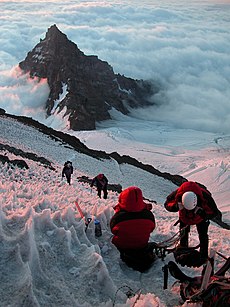
Back Bergklim Afrikaans Bergsteigen ALS Alpinismo AN تسلق جبال Arabic Alpinismu AST Alpinizm Azerbaijani Альпінізм Byelorussian Алпинизъм Bulgarian পর্বতারোহণ Bengali/Bangla Alpinizam BS

Mountaineering, mountain climbing, or alpinism[1] is a set of outdoor activities that involves ascending mountains. Mountaineering-related activities include traditional outdoor climbing, skiing, and traversing via ferratas that have become sports in their own right.[2][3][4][5] Indoor climbing, sport climbing, and bouldering are also considered variants of mountaineering by some,[6][7] but are part of a wide group of mountain sports.
Unlike most sports, mountaineering lacks widely applied formal rules, regulations, and governance; mountaineers adhere to a large variety of techniques and philosophies (including grading and guidebooks) when climbing mountains.[7][8] Numerous local alpine clubs support mountaineers by hosting resources and social activities. A federation of alpine clubs, the International Climbing and Mountaineering Federation (UIAA), is the International Olympic Committee-recognized world organization for mountaineering and climbing.[9] The consequences of mountaineering on the natural environment can be seen in terms of individual components of the environment (land relief, soil, vegetation, fauna, and landscape) and the location/zone of mountaineering activity (hiking, trekking, or climbing zone).[10] Mountaineering impacts communities on economic, political, social and cultural levels, often leading to changes in people's worldviews influenced by globalization, specifically foreign cultures and lifestyles.[11]
- ^ "Alpinism Definition & Meaning | Dictionary.com".
- ^ Whitlock, W., Van Romer, K., & Becker, H. (1991). Nature Based Tourism: An Annotated Bibliography Clemson SC: Strom Thurmond Institute, Regional Development Group.
- ^ Pomfret, G. (2006). "Mountaineering adventure tourists: a conceptual framework for research". Tourism Management. 27 (1): 113–123. doi:10.1016/j.tourman.2004.08.003.
- ^ Beedie, P.; Hudson, S. (2003). "Emergence of mountain-based adventure tourism". Annals of Tourism Research. 30 (3): 625–643. doi:10.1016/S0160-7383(03)00043-4.
- ^ Apollo, Michal (2017). "The true accessibility of mountaineering: The case of the High Himalaya". Journal of Outdoor Recreation and Tourism. 17: 29–43. doi:10.1016/j.jort.2016.12.001.
- ^ Coalter, F., Dimeo, P., Morrow, S., & Taylor, J. (2010). The Benefits of Mountaineering and Mountaineering Related Activities: A Review of Literature. A Report to the Mountaineering Council of Scotland
- ^ a b Apollo, M.; Wengel, Y. (1 October 2021). "Mountaineering Tourism: A Critical Perspective". Routledge.
- ^ Thomas Kublak (8 June 2014). Mountaineering Methodology – Part 1 – The Basics. Tomas Kublak – MMPublishing. ISBN 978-80-87715-12-3.
- ^ "UIAA Activities". UIAA. Archived from the original on 11 May 2011. Retrieved 2 January 2015.
- ^ Apollo, M. (2021). Environmental Impacts of Mountaineering. SpringerBriefs in Environmental Science. doi:10.1007/978-3-030-72667-6. ISBN 978-3-030-72666-9. S2CID 234774157.
- ^ Apollo, M.; Andreychouk, V. (2022). Mountaineering Adventure Tourism and Local Communities: Social, Environmental and Economics Interactions. Edward Elgar Publishing. ISBN 9781802209372.